- Home
- News
- What’s On
- Activities for Children
- Arts & Crafts
- Autos and Bikes
- Business events
- Car Boot & Auctions
- Charity events
- Churches & Religious
- Comedy
- Dance
- Days out & Local interest
- Education
- Exhibition
- Film
- Gardening & Horticulture
- Health
- Markets & Fairs
- Music
- Nature & Environment
- Spiritual
- Sport
- Talks and Discussions
- Theatre and Drama
- Business
- Local Information
- Jobs
- Deaths
- Charity events
- Contact Us
The largest character in Macclesfield’s history
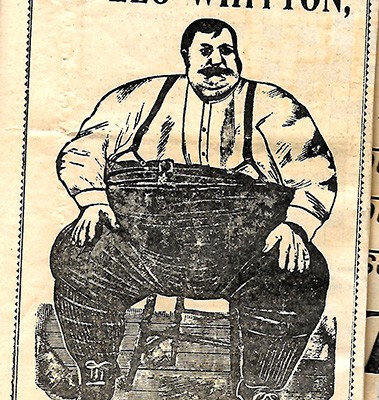
It was not the most auspicious of arrivals to Macclesfield for such a famed person as he.
The celebrity arrived by steam train at Hibel Road station around the Easter of 1899 and his reception committee had to spend a good few minutes levering him out of the railway carriage as he contorted his body to fit through the door. Then – as he huffed and puffed on the platform – a coal wagon from the nearby coal-sheds owned by John Potts was brought to transport him to his lodgings. He could hardly walk.
Unfortunately for the man termed The Canadian Colossus, then had to climb aboard his makeshift horse-drawn carriage and another scene to rival a silent movie comedy was re-enacted at the London and North Western Railway’s station as he was pushed and pulled up a gangplank to the dirty and dusty cart. This was to be his means of transport across Hibel Road, Gas Road, into The Waters, along Sunderland Street before turning left onto Mill Lane and his lodgings at the Orange Tree Inn.
We can only imagine the stir that 41 year old Leonard ‘Leo’ Whitton’s arrival created in the town. No doubt this 51 stone fairground ‘sideshow freak’ would have been viewed atop the coal wagon with amusement, awe and fascination by the onlookers.
The man billed as “The Fattest Man in the World” was the guest of the pub’s landlord George Woods, who no doubt had his eye on a money-raising opportunity. There was a time when the World’s Largest Fat Men or Women were very popular attractions on the Midways and in the Dime Museums across America, and Leo was famous throughout Canada, America and then Britain for his huge girth. He had visited Manchester and other parts of Lancashire where his parents had been born. Whether he had any family left around there is unknown, but he exhibited himself in fairs and circuses throughout the England before arriving in Treacle Town. He had, according to a newspaper cutting I possess, met “a Macclesfield person of note” on his travels and this may have sown the seeds for his visit here.
Rumour had it that his manager had “done a bunk” with the weekly takings, and Leo was left high and dry, but why Macclesfield was his final port of call is conjecture. He had been accompanied by his youngest son whilst in England, but what happened to him is as mystery. There was a lodging house in Buxton Road that “theatricals” used (the town had a vibrant theatre in Mill Street) so he would have been welcomed there – should he have been able to fit through the door that is. Maybe George Woods took pity on him.
He was soon joined by a fellow sideshow worker named John Pyatt, who, being less than three feet in height, was known as Tiny Tim.
Leo had a specially-made pocket inside his jacket and Tiny Tim would hide in there and for extra money would be shown to the audience. The tiny man was later to be buried in Macclesfield cemetery close to his large pal.
Leo was born in the county of Northumberland, Canada, in 1857, his parents emigrating in 1850. His mother weighed 375 lbs and his father 340. Both maternal grandparents lived to a good old age and were described as “strong, heavy people”.
When Leo was 12 he weighed 209 lbs and when 20 he was 350 lbs, working on his parents’ farm. A year later he opened a butcher’s shop in Brighton, Canada, and married a Miss Foucher who was from a neighbouring farm.
It was after this that he put on 100 lbs in five years and this continued until he weighed 727 lbs and had a family of five children. His weight prevented him from working and to eke a living for the wife and children he was forced, with great reluctance, to go on show.
A pamphlet advertising his attractions said he was always of temperate habits, very moral character, jovial companion, a good husband, fond father and excellent citizen and claimed he was of such good, sound judgement as to often be consulted on matters of business connected with the welfare of the town. It was claimed he ate less than an ordinary-sized man, had perfect health, while his muscles were like iron. Further he was “of such strength that could he exercise like an athlete he would no doubt beat the world’s record in lifting, etc., but is forbidden to use any violent exercise.”
Unfortunately, this proved to be a flight of fancy for poor Leo was to take an afternoon nap in his room at The Orange Tree and never woke up. His heart gave out.
Joseph Lowe was a Macclesfield undertaker and a publican at the Jolly Sailor in Sunderland Street and he fell to him to organise Leo’s burial. It was become part of Macclesfield’s folklore that a window had to be taken out of the pub in order to get the coffin out, and then a block and tackle was used to lift it onto a brewer’s dray cart for transportation to Macclesfield Cemetery.
But the Canadian Colossus’s dignity was further diminished when, upon arrival at the burial plot, the hole –a normal one – had to be extended by three feet to accommodate the bulky receptacle. A large crowd waited with both patience and impatience for three hours before the interment could be carried out.
Vital statistics
Leo was 5 feet 10 inches tall, his neck measured 26 inches, the girth of his arm was 28 inches, his chest 72 inches, waist 84 inches, the girth of his thigh 49 inches, legs 25 inches and he weighed 51 stone.
His coffin was made of one and a half inch oak boards and was 6ft 3in in length, 3ft 6in wide and 2ft 6in in depth.
He is buried in the same plot as a George Wood died 21st March 1919 aged 66 and his wife Mary Wood died February 4th 1945 aged 89.
All copy and images ⓒ Doug Pickford 2016

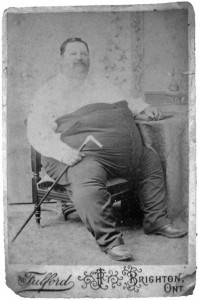
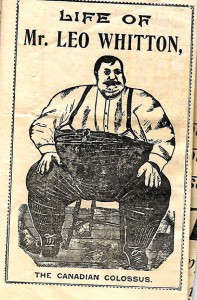
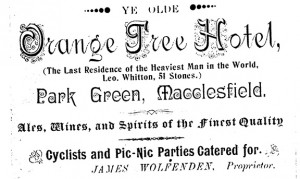
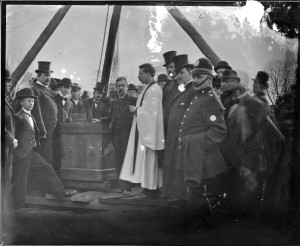
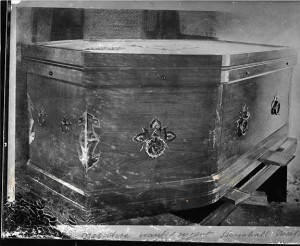
You must be logged in to post a comment Login